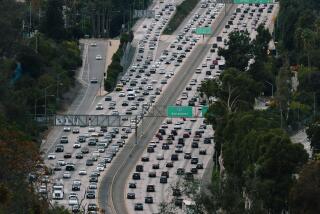NEWPORT BEACH : Pothole Repair Not Just a City Matter
- Share via
Because of the preponderance of rain this year, city officials have been fielding a glut of phone calls from frustrated drivers dodging and sometimes thumping into ever-widening potholes.
But there is nothing the city repair crews can do on portions of Newport Beach’s heavily traveled state highways through the city, and that is where the potholes are widest and deepest.
“There are some so wide you can’t even straddle them with your car,” said David Niederhaus, director of the city’s General Services Department. “It is frustrating to me because when people see litter or potholes on the streets, they blame the city.”
The city has its own three-person work crew--and a backup crew--who respond to pothole reports within hours or a day. But holes in the state highways traversing the city have to be left to the California Department of Transportation.
“Newport is unique that way,” said Richard Edmonston, traffic engineer for the city. The areas Caltrans are responsible for are MacArthur Boulevard between Bison Avenue and Ford Road, Coast Highway, Bristol Street near John Wayne Airport, and Newport Boulevard from City Hall to Hospital Road.
City officials say they have received numerous complaints.
“One guy called in recently and said there are so many potholes you can’t even dodge them all,” Edmonston said. “I feel badly. The best we can do is give (the caller) a name and a number at Caltrans if they want to vent frustration.”
The city does not touch those streets because of the potential liability and the unlikelihood that the state will reimburse for repairs. Also, they are not staffed to handle the extra roadway, Niederhaus said.
Caltrans has difficulty tending to the streets because that agency also is responsible for the freeway system and other surface streets throughout the county.
“They are doing them as fast as they can,” Niederhaus said of the Caltrans road crews. “But it generally takes several phone calls and several days to get a road problem cleared up with Caltrans.”
A pothole is created by rainwater that seeps through cracks in the pavement and then undermines the soil to the point where the road collapses.
The continually wet weather not only creates problems but prolongs them.
“Unless they get really really deep, you need to let the hole dry,” Niederhaus said. Crews respond by filling them with bags of compressed asphalt and then smoothing them over. But the recent trend of wetness has made a dry hole hard to come by. “You need at least three or four days for them to become dry,” he said.
But pothole problems really begin before the rain ever hits the pavement.
“You have to do crack sealing in fall before the bad weather gets here.” Niederhaus said. “Crack sealing now is a little too late.”
The Making of a Pothole Hundreds of potholes have appeared in Orange County because of recent storms. They can form in just a few hours after asphalt roads have been drenched. 1. Water under the road Rainwater sinks through cracks in old or weakened asphalt. The water is soaked up by the mixture of rock, gravel and sand that supports the road. 2. Roadbed erodes Vehicles passing over the road force water through the soggy roadbed, eventually eroding parts of it. 3. Asphalt breaks away Asphalt sinks into the eroded portions of the roadbed and eventually cracks under the continued impact of vehicle tires. Chunks come loose. 4. Repairs Holes may first be patched with “cold” asphalt, which does not require special equipment.Later, a permanent repair is made with hot asphalt and steamrollers. Damage to the Car Potholes can sometimes cause several hundred dollars worth of damage to cars. If the steering seems unusual or other problems appear, have the vehicle checked. Potholes Can: Flatten a tire Bend a wheel Ruin wheel alignment Damage shock absorbers or suspension struts Damage parts under the car, if it “bottoms out” Source: County and city public works department, Auto Club of Southern California and Anaheim Hills Tire
More to Read
Sign up for Essential California
The most important California stories and recommendations in your inbox every morning.
You may occasionally receive promotional content from the Los Angeles Times.













